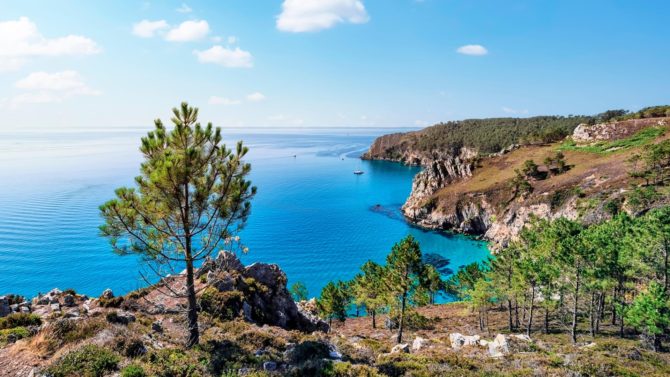How to travel around the world without leaving France

Mais alors!, some of you may say, what about our search for relaxation on a tropical beach somewhere in the Caribbean? Feeling awed by a never-ending mountain plateau and its population of wild horses in Mongolia? Witnessing the mesmerising colours of salt lakes in South America? What if I told you France has all that and more. You just need to know where to look.
Las Coloradas in Yucatan, Mexico
In Mexico, travellers and photographers come from far and wide to witness the vibrant pink colours of a lagoon in the Yucatan peninsula. The lagoon, only a few centimetres deep, is used to harvest salt. It is certainly impressive, with colours raging from salmon-pink to bright fuchsia that contrast with the silver-white sand crystallising on the banks of the lakes.

IN FRANCE: La Camargue in Bouches-du-Rhône and Gard
In the south of France, the salt marshes of the Camargue offer a breathtaking spectacle to match. Hectares of geometric lagoons, tainted pink, spread along the coast of Provence. The colour comes from a natural marine micro-organism containing beta-carotene, the same pigment that gives flamingos their pink and orange hue. Aigues-Mortes is one of the most famous sites and, when viewed from the marshes, the old fortified city seems to float on a bright pink sea. Mounds of pure white salt, sometimes so big they are more like hills, gathered by the salt workers make for picturesque and contrasting scenes. The Camargue is also home to Europe’s largest gathering of flamingos and you can easily observe the flocks as they amble around the pink waters.
The Everglades in Florida, USA
The vast natural reserve of the Everglades in southern Florida is one of the world’s most important wetlands and is listed as a UNESCO World Heritage Site. Visitors can walk along pathways and wooden walkways or take to the water on a high-speed air boat that seems to hover over the water. It is an exciting place, made all the more so by the presence of crocodiles, manatees and panthers roaming freely in this unique region.

IN FRANCE: La Brière Natural Park in Loire-Atlantique
Much like the Everglades, the Brière Natural Park is also a protected natural area made up of marshes and wetlands, minus the man-eating animals. Located north of Saint Nazaire, it is a fantastic bird-watching spot and, as it is close to the Loire-Atlantique salt marshes and tidal rivers, is also home to a huge variety of aquatic plants. Visitors can enjoy a much more leisurely pace than in Florida by stepping aboard a flat-bottomed boat called a chaland, while hiking, horse-riding, cycling and canoeing are more active ways to fully appreciate the surroundings. La Brière is also known for the thatched-roof houses that dot the park.
Tropical beaches of the Caribbean
We can all conjure up idyllic images of the tropical beaches of the Caribbean islands: turquoise blue waters, white sandy beaches, palm trees… havens of rest and relaxation far away from work, traffic jams and the numerous demands of 21st-century life. Barbados, the Antilles and Antigua all offer paradise-like beaches, and while islands such as Guadeloupe and Martinique are in fact French, the journey is long and the carbon footprint heavy.

IN FRANCE: The beaches of Brittany
Brittany is much closer to home and more than holds its own when it comes to beautiful tropical-like beaches. There are two beaches in Finistère nicknamed plage de Tahiti by the locals – Nevez and Carantec – and for good reason: crystal-clear and turquoise blue water, a long, white sandy beach and breathtaking views of the Glénan archipelago for the former and the Morlaix bay for the latter. And then there’s the Crozon peninsula and particularly the île Vierge: the beaches of white sand and aquamarine waters are flanked by rugged cliffs where the vegetation clings to rocky outcrops far above. The Plage des Grands Sables beach off the Ile de Groix is also impressively close to something you’d find in the Caribbean. Convex in shape – one of the only ones in Europe – it juts out into the sea where bobbing sailing boats drop their anchors.
The Mongolian-Manchurian grassland in Mongolia
The Mongolian-Manchurian grassland is a huge ecoregion of grasslands, savannas and shrubland extending across central and eastern Mongolia, to the border with China. Its large expanses of grass are inhabited by master horse-riders who let their horses and mares walk around freely, while tourists come for the horse-riding opportunities and mountain bike treks on offer.

IN FRANCE: Lac de Nino in Corsica
High up in the mountains of Corsica, along the long-distance GR20 hiking route, is the Nino lake, located at an altitude of 1,743m on the Camputile plateau. It is surrounded by an unusual and very striking landscape of grassland and what the Corsicans call pozzine – little clumps of damp moss. Here, horses, cows and pigs roam around freely while the jagged peaks of mountains look down upon them. You can walk all the way there but camping is not permitted by the lake.
Yosemite National Park in California, USA
Yosemite’s spectacular waterfalls and huge granitic domes attract millions of visitors every year. Located within the Sierra Nevada mountains, most of the park is protected and its access forbidden to visitors; they can only explore 36km2 of the whole park, in the Yosemite Valley.

IN FRANCE: The Vercors mountain range in Isère
For those who love the outdoors, the Vercors mountain range retains a kind of untouched and wild nature. Here too, impressive peaks soar abruptly and dramatically towards the sky, like the Mont Aiguille, while the green plateaus are home to wild bouquetins and vultures (recently reintroduced) as well as herds of sheep and their huge guard dogs, Patous. Easily accessible from Grenoble, it is a stunning natural park, probably my favourite in France, which you can explore on foot along the GR91 for example or on a mountain bike.
The Amazon river in Brazil
The longest river in the world winds its way for at least 6,400km across southern America, mostly in Brazil. More than two-thirds of its basin is covered in rainforest, the world’s largest reserve of biological resources. Ecotourism in the Amazonian rainforest is becoming increasingly popular while adventure or luxury cruises allow travellers to be carried along on this awesome river at its flowing pace.

IN FRANCE: The Sioule river in Auvergne
In France’s Auvergne region, where dormant volcanoes create an intriguing yet beautiful mountainous landscape, is the Sioule river which meanders through the lush forests of the Massif Central. Its source is located in the Monts Dore chain at just over 1,000m high. There is a particularly famous meander close to the village of Queuille which distinctly resembles the winding course of the Amazon river. You can see it from the excellent vantage point at the Paradis belvedere, close to the village. Many species thrive alongside and in the waters including otters and salmon and it is a well-known fishing river. The best way to see it though is to hire canoes or kayaks for a fun day on the water.
Monument Valley in Arizona, USA
Located at the border between Arizona and Utah, this valley on the Colorado plateau is famous for its huge sandstone buttes, rising steeply to up to 300m high. They are a natural geomorphological formation although some parts of the plateau have been mined by man. They have been featured in many a cowboy film and are a major tourist attraction.

IN FRANCE: Le Colorado Provençal in Rustrel, in Vaucluse
In the heart of the Luberon, in the south of France, is the Rustrel canyon, also known as ‘le Colorado Provençal’. This site is in fact one of the largest ochre deposits in the world. Natural erosion but also man-made quarrying activities from the 19th and 20th centuries have created large, soaring rock formations. The deep orange, red and gold colours of the ‘cliffs’ and rock ‘chimney towers’ in this canyon are due to natural ochre pigments present in the soil. It is an eerily beautiful place and you almost expect to see John Wayne emerge from around the corner of a red boulder.
Share to: Facebook Twitter LinkedIn Email
More in France Travel, French activity holidays


